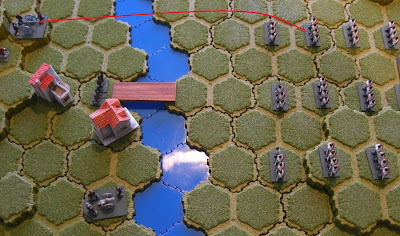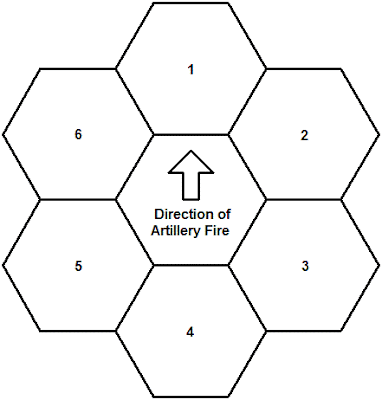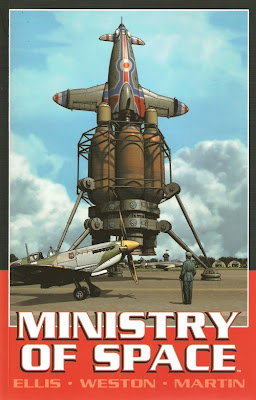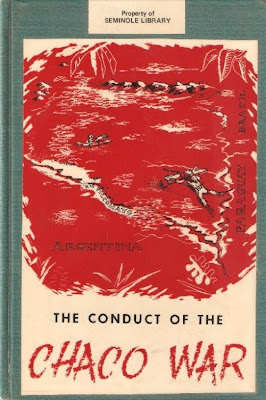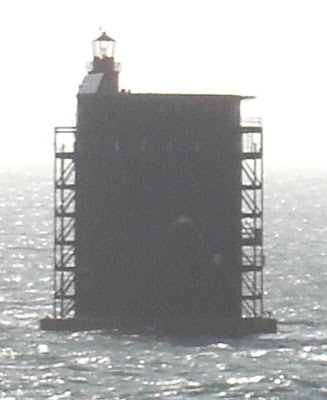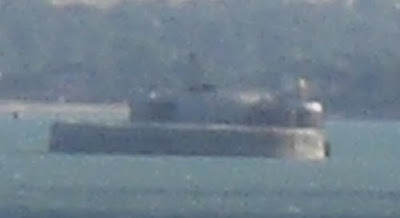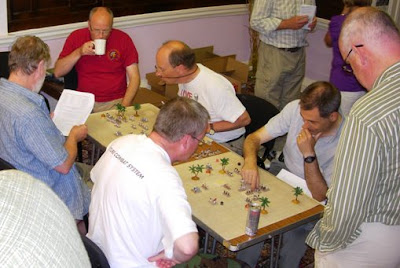Despite terrible traffic (it took me over four hours to drive from South East London to
Knuston Hall in Northamptonshire – twice the travel time calculated by my satnav!) I managed to get to
COW2010 in plenty of time for the specially arranged plenary session before dinner.
Tim Gow and I had decided that we needed to mark Paddy Griffith’s death with some form of special session, and that it should be held before dinner on the first night of the conference. It was kept as simple as possible, and began with Tim explaining the events leading up to Paddy’s untimely death and what had subsequently happened. I them followed with my memories of Paddy and a brief reminder of his work, especially with regard to his creation of
Wargame Developments and
COW (the
Conference of Wargamers).
The Plenary GameOn the original
COW programme it was planned that Paddy would run the Plenary Game, and that the subject would deal with World War I. Tim Gow and the other Sheffield members of
Wargame Developments kindly offered to organise a replacement game, and after dinner most of the attendees could be found on the Knuston Hall lawn preparing to assault the German trenches (or as in my case, defend them). Most were armed with cardboard rifles (with baynots!), although I did see at least one cardboard mortar and several cardboard machine guns. The Germans were armed with three cardboard Maxim machine guns and several broom-handle Mauser pistols.
The first two British attacks were unable to break through the German trenches – although they came very close to doing so on the second attempt – but by 1918 (the third of the assaults) they had learned the lessons of earlier setbacks and – with the cunning use of a tank that looked very much like two men carrying a crate and another saying ‘Clank! Clank!’ at regular intervals – they were able to smash through three lines of German trenches and into the open land beyond (The Germans were heard to mutter afterwards about how they had been stabbed in the back, but that is altogether another story and another game).
This game was very much in the tradition of Paddy’s ‘silly hats’ games, and I think that he would have approved of the efforts made by the game’s designers and the enthusiasm with which it was played by those who took part.
Friday Night After Dinner GamesOnce the Plenary Game was over and packed away, several ADGs (After Dinner Games) were staged.
We Shall Be KingsA very typical Tim Price game that involved the players trying to find Saddam’s hidden treasure in post-war Iraq.

Lots of fun and skulduggery seemed to be taking place at the time when I looked in on the session, and the feedback I got from some of the players was extremely fulsome – as it always is for one of his games.
The Elephant In The RoomThis was Graham Evans game that pitched
velites against the ‘tank’ of the ancient world – a war elephant.

The game was very elegantly crafted both in terms of the rules and the models used. I did hear Graham utter one memorable quote during the time I was watching one of the games played:
‘You are the first person to play this game who has managed to get their velites all killed during the first round!’The Birds Are Singing And It’s a Wonderful Day!Dick Scholefield first brought this game to
COW some years ago, and it was nice to see it again. Attendees who had never previously played were able to sample Dick’s very clever role-play game with 1:300th scale figures on a 1:300th scale terrain.

A platoon of British troops had to patrol an area of Northern France in the period just after the Normandy breakout, and during their patrol they were faced with a series of situations to which they had to respond. Each patrol had a set of different randomly generated problems, and it tended to generate a fast learning curve for the players. A classic game which still has much to teach us!
The EndThis very clever game has been put on as a participation game at several wargames shows this year by the members of the
Wargame Developments Display Team North.

As can be seen from the photograph, this game has high production values as well as having a very simple to understand – but nevertheless sophisticated – set of ‘rules’. Each player tries to stem the advancing Allied tide by using a restricted number of counter-attacks and ‘secret’ weapons. The End is inevitable; what counts is how long you can put it off!
Saturday Morning SessionsSaturday morning sessions tend to be a problem for me because there is always at least two sessions on at the same time that I want to take part in. This year I opted to sign up for Richard Brook’s OP14, where I took on the role of being a German
Korps commander.
OP14Some time ago I designed and tested a set of operational-level World War II wargames rules. These were published in
THE NUGGET and inspired Richard Brooks to produce a set of operational-level rules for the Great War. This morning’s session gave me the opportunity to try them out … and I was mightily impressed.

The game mechanisms were similar to those Richard has used in several of his previous wargame designs and were thus very easy for me to grasp within a relatively short time.

There were, however, some very specific differences due to the higher level of command each player represented. The resulting game mechanisms might be too abstracted for many mainstream wargamers, but they did enable us to fight a day of World War I combat in less than three hours
and to achieve a generally historical result.
 Contact, Tanks! East!
Contact, Tanks! East!This was a session that I had wanted to go to, but because it clashed with OP14 all I was able to do was to pay it a flying visit.

Wayne Thomas and David Brock always put on excellent games with well thought-out mechanisms and beautifully presented models and terrain. This was no exception. The battle that was recreated was a clash between Allied – mainly French – troops and the Iraqi Republican Guard during the 1991 Gulf War. From what I saw of the session it was an exciting battle that the Allies were winning … but at the cost of quite a few casualties.
World War I DogfightThis was another session that I was only able to pay a short visit to, but I was immediately struck by the high production values as well as game mechanisms that were on show.
 Saturday Afternoon Sessions
Saturday Afternoon SessionsThe afternoon programme was equally crowded with attractive sessions, and I decided to spend my time visiting as many as I could rather than just taking part in one or two. But first I did take part in a short and hilarious game involving zombies!
Killing ZombiesThis was a very short impromptu game set up by Jim Wallman and played on the lawn. Four ‘survivors’ (i.e. non-zombies) had to make their way through a crowd of hostile zombies that were intent upon killing them. If three of the four could reach safety, the Human Race would survive; if not, the Human Race was doomed. All that each of the ‘survivors’ had to protect themselves was a gun, but this was only capable of halting a zombie, not ‘killing’ one.
I was a ‘survivor’ … but I failed to reach safety by just a matter of feet. I am sorry to report that as a result, the Human Race is doomed!
Les Petite BataillesOver the past few years Mike Elliott has been developing a series of simple rules for fighting a variety of different nineteenth century wars.

This addition to that series has been designed for refighting battles from the Napoleonic era and uses 6mm figures mounted on bases that represent a battalion.
Sharp End – Back To BuggerupistanThis is a set of rules that Phil Barker has been developing for some time, and I think that this is the third year running he has brought along the latest version for play-testing.

It started with a very empty battlefield that was being over-flown by a ‘Predator’ unmanned surveillance aircraft, but as the scenario developed more and more NATO troops were deployed to meet the developing threat.

I must admit that I cannot bring myself to wargame this current conflict, but from what I have seen the mechanisms that Phil has used work well and produce reasonably accurate results.
The Last CrusadeHad I been on the ball I would have signed up for this session even though it is not a period that I have a particular interest in.

The reason why is because it was being run by Ian Drury – whose games are always excellent – and because it used a gridded battlefield – which is something that I am very in favour of. In this case the grid was created using vinyl floor tiles on which was printed a four by four grid of ‘tiles’. These are relatively cheap to buy (if you can find a stockist!), are very durable, and can be drawn on with water-based OHP pens.
A Place In The SunTim Price is always an excellent speaker. He is humorous, a little irreverent, and very informative, and this talk about his deployment as a member of the NATO training team in Iraq was an eye-opener.
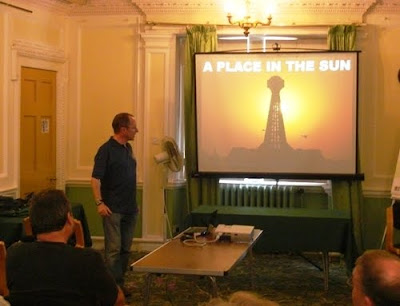
The talk covered:
- The purpose of the NATO Training Mission to Iraq
- The pre-deployment training he underwent and the kit he was supplied with
- What daily life was like for a member of the Training Mission
- What it was like to work in the IZ
- Understanding the Arabs
Saturday Night After Dinner GamesAfter dinner I took part in what appeared to be a very silly game that actually had a very serious lesson. I then had a short break before returning to the fray.
Spock’s Shameful SecretThis was not a Star Trek game although a Vulcan was involved. It was intended to recreate the logistical problems involved in the famous ‘Black Buck’ attack on Port Stanley airfield during the 1982 Falklands War.
The players represented either the Vulcan’s crew (a pilot, and flight engineer, and a bombardier) or Victor tankers. The ‘aircraft’ all had fuel tanks (plastic beer glasses with a hole drilled into the bottom that were filled with water) which needed to be kept topped up if the Vulcan was not to run out of fuel (in this case water) before it reached Stanley.
This sounds simple … but it isn’t! The Victor tankers had to refuel each other to keep sufficient tanker aircraft in the air so that they could refuel the Vulcan. We had two attempts, and on the second the Vulcan reached and bombed the airfield just as it ran out of fuel. Mind you, they missed the runway but they did hit the airfield!
Anti-U-Boat Wargames of the Western Approaches Tactical SchoolI missed the start of this session so all I was able to do was to pay it a short visit.

John Curry has been able to reconstruct the tactical wargame used by the Western Approaches Tactical School to train Royal Navy officers in anti-U-Boat warfare. This famous game has been all but lost for many years, and it has taken some time for John to research into what it looked like and how it worked. This session was the result of that diligent work.
Tank Terror!This was a short, fun game that pitted motorised model tanks against ant-tank defences.

The defenders had several ‘weapons’ that they could use (anti-tank grenades [Diet Coke tins that had to be thrown into a crate to ‘hit’ the designated target tank] and bazookas (ball pens dropped from shoulder height using an outstretched arm; the ball pens had to hit a small picture target of the tank it was aimed at to ‘hit’ and ‘kill’ that tank). When a tank was ‘hit’ its electric motor was switched off and it stopped.
Early WargamesWhen I was young I never owned any of the boxed ‘wargames’ that were on the market; this session gave the opportunity to finally try some of them.
The games that were available included ‘The Battle of Balaclava’ …

… Triang’s ‘Combat’ (with its beautifully sculpted figures by Stadden, that were later sold in sets by Almark) …

… and Waddington’s ‘Battle of the Little Big Horn’.
Sunday Morning SessionsSunday morning was when my session was scheduled to take place.
Joseph Morschauser: Forgotten Pioneer?There were only eight names on the sign-up sheet for my session so I expected to have a quiet and fairly informal presentation followed by everyone having the opportunity to try of Morschauser’s ‘Frontier’ wargamer rules … but then nearly twenty attendees turned up!
The presentation seemed to go fairly well, and there were quite a few interesting questions and comments made. The practical part of the session was also well attended, with attendees staying to watch even if they were not going to get the opportunity to use the rules themselves. In fact attendees who did have that opportunity wanted to carry on with their battles even after the session was supposed to have ended, but eventually they had to pack away so that the next session could be set up.
I got lots of very positive feedback after the session, and John Curry is seriously considering republishing Joseph Morschauser’s book.
Washington's ArmyThis is the latest incarnation of
Peter Pig's American War of Independence wargames rules. Martin Goddard and Rob Roriston put on two sessions to give attendees the opportunity to try out the latest version of these rules.
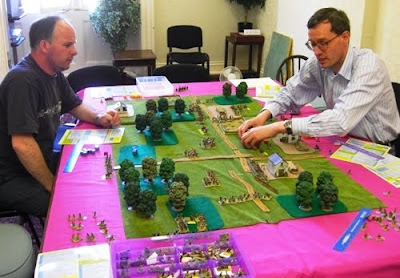 Fire So Close You Are Splashed By His Blood
Fire So Close You Are Splashed By His BloodThe session that followed mine in the Panelled Room was David Bradbury’s wargame about galley warfare in sixteenth century Mediterranean. He brought an earlier version of this wargame to last year’s
COW and it was obvious from what I saw that it has undergone continued development.

What is interesting is the way he mixed the use of small scale model warships on the tabletop with representations of each galley and its crew in 25mm scale.
A Few Acres Of SnowMartin Wallace always brings a wide selection of new and prototype games to
COW, and this was a typical example.

He put on several sessions during the course of
COW, and I was able to spend a few minutes watching him demonstrate this particular game about the Anglo-French war for the control of North America to Michael Young.
Drumfire: Corps-level Trench Warfare In The First World WarElsewhere Martin Rapier ran a very nicely presented World War I wargame. The players had to plan and then execute a Corps-level attack on the German trenches.

As one would expect, there was a lot of artillery available to support the attack as well as aircraft and tanks.

 Return To The River Don
Return To The River DonFor the past few years Graham Evans (AKA
Trebian of
Wargaming for Grown-Ups) has been developing a set of wargames rules that cover the Russian Revolution and the subsequent Allied Intervention and Civil War.

What struck me as I watched this session was both the quality of the models he was using …

… and the very professional look of the rule booklet he had given to the participants.
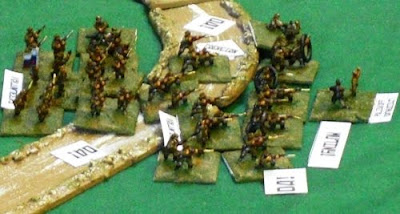
I hope that he makes these rules available to a wider audience as they produce interesting, enjoyable, and realistic wargames set in a somewhat neglected historical period.
Return To DemocracyI happened to pop in to see what this session was about … and promptly found myself taking part!
This was a typical Jim Wallman game that combined a real-world scenario transposed to a Science Fiction setting. A small planet with deposits of a much-needed mineral had, until recently, been ruled by a fanatical dictator who was supported by a ruthless military machine (Does this sound familiar?).
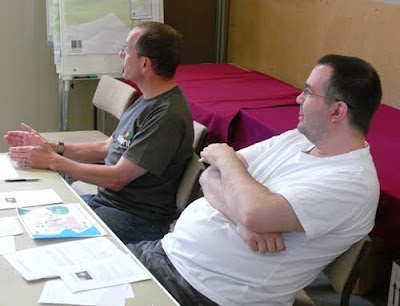
The dictator had been overthrown by rival politicians with the assistance of military forces from a nearby group of allied planets. These forces (led by Tim Price and Nick Drage) had then remained ‘on world’ to help the interim provisional government to maintain peace and to train a new local militia/paramilitary police/self-defence force. They had also offered to help the planet’s economy by investing in new infrastructure projects and assisting them to exploit the mineral deposits.

The locals (led by Gavin Parnby, Rob Cooper, and Jerry Elsmore) managed to negotiate a staged withdrawal of the military forces that were there to ‘assist’ them, but it felt like a close-run thing at times!
Sunday Afternoon SessionsBecause
COW ends by 4.00pm, and the
Wargame Developments Annual General Meeting is held at 3.00pm, the Sunday afternoon sessions are always somewhat abbreviated.
Der Grosser Schweiger – The Life And Career Of Helmut V Moltke The ElderThis was an illustrated lecture by Richard Brooks about the life of Moltke the Elder. As usual Richard’s lecture was very informative and peppered with humorous comments and anecdotes about his subject, and I came away with a far better understanding about Moltke and his influence on the armies of Prussia and – after 1870 – the German Empire.
 Conclusion
ConclusionThe death of Paddy Griffith could easily have cast a pall over
COW2010, but everyone there was determined to mark Paddy’s passing by trying to make it the best
COW ever. It is too early to decide whether or not we managed that, but I certainly came away feeling that my wargaming batteries were well and truly recharged and my enthusiasm for the hobby had been rejuvenated.
 D6 dice were again thrown by both sides to determine who would move first this turn. The Maldacians threw a 4 and the Lauranians threw a 3, and as a result the Maldacians therefore moved first yet again.
D6 dice were again thrown by both sides to determine who would move first this turn. The Maldacians threw a 4 and the Lauranians threw a 3, and as a result the Maldacians therefore moved first yet again. The leading Infantry Unit of the central column stormed across the bridge and engaged the Lauranian Border Guards who were protecting it. Both sides threw a D6 die; the Maldacians scored 2 and the Lauranians scored 5. As both Infantry Units had to score 5 or less to destroy the other, both Units were destroyed!
The leading Infantry Unit of the central column stormed across the bridge and engaged the Lauranian Border Guards who were protecting it. Both sides threw a D6 die; the Maldacians scored 2 and the Lauranians scored 5. As both Infantry Units had to score 5 or less to destroy the other, both Units were destroyed! Turn 5
Turn 5 D6 dice were thrown yet again by both sides to determine who would move first this turn. The Maldacians threw a 5 and the Lauranians threw a 6, with the result that the Lauranians moved first.
D6 dice were thrown yet again by both sides to determine who would move first this turn. The Maldacians threw a 5 and the Lauranians threw a 6, with the result that the Lauranians moved first. The Maldacians responded by falling back. Their commander realised that in order to fulfil his orders he would have to take further casualties, and as his force had already lost over 40% of its Infantry Units, it was becoming increasingly obvious that success would be bought at too high a price … especially as the two countries were not actually in a state of war! He would make this clear in the secret report he would write to the Minister of War … along with a long memo about the need for more training by the Artillery.
The Maldacians responded by falling back. Their commander realised that in order to fulfil his orders he would have to take further casualties, and as his force had already lost over 40% of its Infantry Units, it was becoming increasingly obvious that success would be bought at too high a price … especially as the two countries were not actually in a state of war! He would make this clear in the secret report he would write to the Minister of War … along with a long memo about the need for more training by the Artillery.